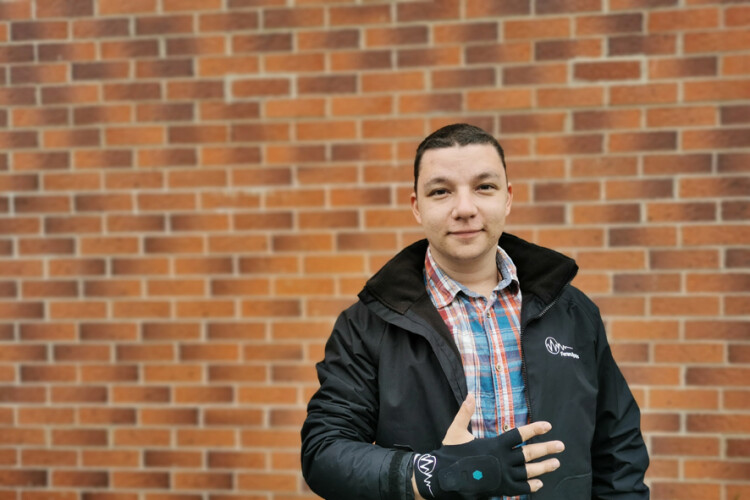International safety standards should be revised after an “unprecedented” level of detail, provided by a smart glove, reveals the risks of hand-arm vibration exposure imposed by powerful machinery on operators.
That’s the view of Andrei Feraru, founder and managing director of Coventry University spin-off company Feraru Dynamics, who said his HAV Sentry glove has widened the parameters of vibration data to the point that global ISO standards are now out of date.
Feraru, a Coventry University mechanical engineering graduate, developed the smart glove in response to the damage done by hand arm vibration syndrome (HAVS), commonly known as vibration white finger.
“I initially had the idea for the HAV Sentry while I was doing a work placement at Rolls-Royce in Derby during my mechanical engineering degree,” he says. “It changed my career path and I decided to invent a product that would ease hazardous exposures in the workplace.”
The glove monitors, in real-time, the vibrations created by the machinery when worn by construction workers operating tools such as grinders, drills and breakers.
A battery-powered monitor on the glove provides a visual indicator of vibration exposure status. A standalone data acquisition and charging station enables information to be gathered, recorded and analysed.
The smart technology continuously records the vibrations created by the tool and analyses the data, alerting operatives when it reaches dangerous levels, so they know to take a break.
The university supported Feraru Dynamics in securing its patent and provided the team with access to relevant engineering facilities and an office space in which they were able to develop the idea into a fully compliant product.
Feraru launched the glove in 2020 after two years of developing prototypes and completing validation tests, helped by a grant of £11,992 from the Coventry & Warwickshire Innovation Programme.
Last year the HAV Sentry glove was trialled by CityFibre and its contractor Callan Connect on a £60m fibre-to-the-premises cable-laying contract in Coventry. And in January this year, Feraru Dynamics announced that it had received its first commercial contract with an order for 10 of the gloves from Coventry City Council.
Meanwhile, the HAV Sentry is currently being evaluated by other potential users, including HS2.
The compliance documentation for the product has already influenced the updating of guidance issued by the HSE to allow for glove-mounted devices to be used for monitoring hand arm vibration exposure.
.png)
Now Feraru is challenging two ISO standards — ISO 5349 and ISO 8041— on the basis that his patented HAV Sentry glove can provide data that goes beyond the current safety parameters concerning acceleration and vibration exposure as well as factors in hand orientation and grip force.
“The current ISO standards for HAV monitoring say themselves that other measurement parameters should be taken into account once they are available. And now they are,” says Ferraru.
“In the UK, we’ve already been able to work with the HSE’s specialist noise and vibration team to discuss the impact of the level of data that can be provided by our HAV Sentry Glove on their own guidance around HAVS.”
The current risk assessment approach to HAVS has been standardised in the UK since 2005, when US manufacturers PCP Piezotronics and Larson Davis lobbied international standards body ISO and the Health & Safety Executive for the introduction of regulations to protect people against vibration exposure.
“However, due to successful lobbying on their part, very specific instrumentation and control requirements were specified based on the existing sensor technology from these two companies,” says Feraru.
Since 2005, sensor technology and algorithms have improved significantly, explains Feraru, and in parallel with these developments, new ways of maintaining robust health at work have been introduced.
“Our HAV Sentry glove now combines the functionality of a compliant Larson Davis real-time measurement of vibration exposure with a real-time wearable alert system for the operators so they know when to take a break or ask for a job rotation,” claims Feraru.
“It also provides the option to analyse the data on a highly complex online dashboard application that automates the risk assessment,” he adds.
The level of detail in vibration exposure risk assessments provided by the HAV Sentry glove includes the traditional acceleration levels (RMS), and also provides valuable insights on operator grip force and hand orientation. This is invaluable in the further training of the workforce, with the aim of improving productivity while reducing vibration exposure, says Feraru.
Feraru says he has support for his HAV Sentry standards improvement initiative from some key figures in the health & safety sector in the UK and overseas. He is now preparing to present his findings at the annual conference of The British Occupational Hygiene Society (BOHS) this month.
“I hope to ignite people’s interest to support my initiative and set new standards for vibration monitoring in the UK,” says Feraru.
Got a story? Email news@theconstructionindex.co.uk



